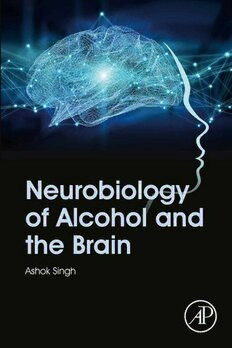
Neurobiology of Alcohol and the Brain PDF
Preview Neurobiology of Alcohol and the Brain
Neurobiology of Alcohol and the Brain Neurobiology of Alcohol and the Brain Ashok Singh Associate Professor, Veterinary Population Medicine, University of Minnesota, St. Paul, MN, USA AcademicPressisanimprintofElsevier 125LondonWall,LondonEC2Y5AS,UnitedKingdom 525BStreet,Suite1650,SanDiego,CA92101,UnitedStates 50HampshireStreet,5thFloor,Cambridge,MA02139,UnitedStates TheBoulevard,LangfordLane,Kidlington,OxfordOX51GB,UnitedKingdom ©2021ElsevierInc.Allrightsreserved. Nopartofthispublicationmaybereproducedortransmittedinanyformorbyanymeans,electronicor mechanical,includingphotocopying,recording,oranyinformationstorageandretrievalsystem,without permissioninwritingfromthepublisher.Detailsonhowtoseekpermission,furtherinformationabout thePublisher’spermissionspoliciesandourarrangementswithorganizationssuchastheCopyright ClearanceCenterandtheCopyrightLicensingAgency,canbefoundatourwebsite:www.elsevier.com/ permissions. ThisbookandtheindividualcontributionscontainedinitareprotectedundercopyrightbythePublisher (otherthanasmaybenotedherein). Notices Knowledgeandbestpracticeinthisfieldareconstantlychanging.Asnewresearchandexperiencebroaden ourunderstanding,changesinresearchmethods,professionalpractices,ormedicaltreatmentmay becomenecessary. Practitionersandresearchersmustalwaysrelyontheirownexperienceandknowledgeinevaluatingand usinganyinformation,methods,compounds,orexperimentsdescribedherein.Inusingsuchinformation ormethodstheyshouldbemindfuloftheirownsafetyandthesafetyofothers,includingpartiesfor whomtheyhaveaprofessionalresponsibility. Tothefullestextentofthelaw,neitherthePublishernortheauthors,contributors,oreditors,assume anyliabilityforanyinjuryand/ordamagetopersonsorpropertyasamatterofproductsliability, negligenceorotherwise,orfromanyuseoroperationofanymethods,products,instructions,orideas containedinthematerialherein. LibraryofCongressCataloging-in-PublicationData AcatalogrecordforthisbookisavailablefromtheLibraryofCongress BritishLibraryCataloguing-in-PublicationData AcataloguerecordforthisbookisavailablefromtheBritishLibrary ISBN978-0-12-819680-9 ForinformationonallAcademicPresspublications visitourwebsiteathttps://www.elsevier.com/books-and-journals Publisher:NikkiLevy AcquisitionsEditor:JoslynChaiprasert-Paguio EditorialProjectManager:BarbaraMakinster ProductionProjectManager:SreejithViswanathan CoverDesigner:MarkRogers TypesetbySPiGlobal,India Preface Alcoholistheanesthesiabywhichweenduretheoperationoflife. G.BernardShaw(1932) Shaw’sviewof1932societymayberelevanttopresentsocietiesbecausemillionsof peoplearoundtheworlddrinkalcoholicbeveragestocopewiththestressofmodern lifestyle.Althoughmoderatealcoholdrinkingmayhavesomerelaxingandeuphoric effects,uncontrolleddrinkingexacerbatestheproblemsassociatedwithalcoholabuse thatareincreasinginnumberandintensityintheUnitedStatesandaroundtheworld. Almost 30 million people in the United States are unable to control their alcohol intake,aremarkable50percentincreasefrom2003.Adolescentsandthose65years or older showed the largest increase in alcohol use disorder. In addition, approxi- mately17%ofmenand8%ofwomenmaydevelopdependence onalcoholintheir lifetime, adding substantial cost to society. Thus, alcohol abuse and ensuing health consequenceshavedevastatedmanylivesandaffectedpatients,families,andsociety. It is important to understand that “alcohol” is a generic term used to represent a group of substances such as methanol (CH OH), ethanol (CH CH OH), propanol 3 3 2 (CH CH CH OH), and isopropanol (CH CH(OH)CH ) that are chemically similar 3 2 2 3 3 but pharmacologically different. Ethanol is usually found in alcoholic beverages. The othertypesofalcohol are notmeant tobeconsumed,butthey may beingested accidentallyorintentionally,resultinginserioustoxiceffectsincluding,butnotlim- ited to,blindness, brain damage, and severe ketosis/acidosis. Althoughresponsibleethanol(alsoreferredtoasalcoholinthisbook)drinkinghas transient pleasant/beneficial effects, uncontrolled drinking may lead to addiction whenabstinencecausessevereadverseeffectsincludingseizuresand,insomecases, death.Thewithdrawalsymptomssubsideupontheresumptionofalcoholintake.As alcoholiswidely available globally, the vulnerable population such aschildren, the elderly,andthosesufferingfromvariousdiseasesmaybeseverelyaffectedbyalcohol drinkingandmaysufferfromitstoxiceffects.Oneoftheaimsofthisbookistostudy the effects of alcohol drinking in patients suffering from mental disorders such as bipolar disorder, schizophrenia, and PTSD. Mixingalcoholwithotherdrugshasbecomeanemergingtrend,exacerbatingpub- lichealthconcerns.Mixingalcoholwithotherdrugssuchasopioidsmaysynergisti- callyaugmenttheseriousnessoftheadverseeffectssuchasthewithdrawalsymptoms, cardiovascular disorders, liver damage, reproductive abnormalities, and behavioral abnormalities.Despitetheseriousnessofthesituation,possiblemechanismsunderly- ingaddictionandthewithdrawalsymptomsarenotyetunderstood.Thishasbeenone of the keyhindrances indeveloping effective treatment. viii Preface The National Institutes of Health (NIH), recognizing the seriousness of alcohol abuse,hasinvestedmillionsofdollarsintheareaofaddiction, resulting inprolifer- ation research articles describing novel mechanistic and therapeutic approaches (a search conducted using “drug abuse” resulted in over 700,000 research papers and over200,000reviewarticlespublishedwithinthespanofthelast65years).However, eachresearchpaperdealswithanarrowareaofdrugabuseandaddiction.Therefore, there is an urgent need to collate the published information and propose a unified hypothesis for mechanisms of alcohol addiction and interactions that will facilitate the development ofnovel treatmentapproaches. Theoverallaimofthisbookistodiscussthemechanismsofpharmacologicaland toxicologicaleffectsofacuteandchronicalcoholexposure,interactionofalcoholwith otherdrugs,alcohol–mentaldisordercomorbidity,currentlyusedmethods,andappli- cationofnanoparticlesinthedevelopmentofnoveltherapies.Thebookconsistsofsix chapters: Chapter1:JourneyFromResponsibleAlcoholDrinkingtoAlcoholism. Chapter2:InteractionofAlcoholWithDrugsofAbuseandMedicines. Chapter3:MentalHealthandAlcoholUseDisorderComorbidity. Chapter4:TraditionalTreatmentStrategiesforAlcoholismandtheWithdrawalSymptoms. Chapter5:NovelNanoparticle-BasedTreatmentApproaches. Chapter6:Conclusions. Theinformationpresentedinthisbookisbasedonacomprehensiveliteraturesearch describedbyGonza´lez-Castroetal.[1]andshowninFig.1.Theinclusionandexclu- sion criteria were established as described by Singh [2]. Initial searches were per- formed on the following literature databases: MEDLINE, Google Scholar, and Fig.1 (A)Flowdiagramusedfortheliteraturesearchforeachchapter.(B)Atypicalsearch conductedforalcoholmetabolismresearch[2]. Preface ix Web of Science using search words either alone or tagged with qualifying words. Some examples are listed below: 1. Alcoholdrinkingtaggedwithstatistics,social,abnormal,gender,age,tolerance,addiction, bloodalcoholconcentrations(BAC),etc. 2. AlcoholdehydrogenasesorADHtaggedwithgeneticpolymorphism,alcoholism,tolerance, demographic (Asians, Indians, Caucasians, Africans, etc.), acetaldehyde, acetaldehyde dehydrogenase—ALDH,bloodalcoholconcentration—BAC,etc. 3. Alcoholism or alcohol addiction tagged with uncontrolled drinking, statistics, demo- graphics,tolerance,brainpathways(dopamine,opiates,GABA,glutamate,NMDA,seroto- nin,adenosine),brainregions,abstinence,withdrawalsyndrome,etc. Othersearchwordsweretolerance,dependence,craving,genomics,epigenetics,and hangover. The initial results were subjected to certain inclusion and exclusion criteria[2]. References [1] T.B.Gonza´lez-Castro,I.Jua´rez-Rojop,M.L.Lo´pez-Narva´ez,etal.,AssociationofTPH-1 and TPH-2 gene polymorphisms with suicidal behavior: a systematic review and meta- analysis.BMCPsychiatry14(2014)196,https://doi.org/10.1186/1471-244X-14-196. [2] A.K.Singh,Alcohol,alcoholismandthewithdrawalsymptomsI.Causesandmechanisms, Arch.Addict.Rehabil.1(1)(2017)31–50. 1 Journey from responsible alcohol drinking to alcoholism 1 Scope of alcohol abuse Ethanol(also referred toas alcohol inthis book) is the principalpsychoactive com- ponentofalcoholicdrinks[1].Unliketheillegalpsychoactivedrugssuchascocaine, amphetamine,andLSD,alcoholicbeveragesarelegalandsociallyacceptedinmany partsoftheworld(Europe>America>AsiaandAfrica>theMiddleEast,andother countrieswherealcoholisbanned)(Fig.1.1,[2]).IntheUnitedStates,heavydrinking ismorecommonin(i)MiddleAtlanticStatesorNewEngland,(ii)morehighlyurban- ized areas, and (iii) certain national or ethnic origins. Although responsible alcohol drinking induces euphoria and provides relaxation with some medicinal benefits, chronicdrinkingisassociatedwiththedevelopmentofaddiction,aconditioninwhich alcoholabstinenceresultsinseverewithdrawalsymptomsthatsubsideuponresump- tionofalcoholconsumption[3,4].Accordingtoa2014WHOreport,about7%ofthe globalpopulation(approximately500million)and10%oftheUSpopulationsuffer fromalcoholismanddrugaddiction.Unfortunately,intheUnitedStates,anestimated 88,000peopledieperyearduetoalcoholabuse,andonlyabout11%ofthoseaddicted toalcoholreceivetreatmentfortheirabusedisorder[5].Thissuggestsalackofacom- prehensivepreventionstrategytocombataddiction,possiblybecausethepublicmay not understand its seriousness toindividuals and society. Considerableindividualdifferenceshavebeenreportedin(i)alcoholconsumption and ensuing intoxication and (ii) development of addiction (defined as a cluster of behavioral, cognitive, and physiological abnormalities as well as the development ofphysicalwithdrawalstateuponabstinence)[6].Studieshaveshownthatonlyabout 6% (9.8 million, 5.3 million women and 623,000 adolescents aged 12–17 years) of alcohol drinkers in the United States aged 18 and above developed alcoholism and otheralcohol-relateddisorders(NIAAA2008).Thisisbecauseonlygeneticallypre- disposed people experiencing socioenvironmental cues develop an addiction in responsetopersistentdrinking[2,3].Althoughpossiblecausesfortheglobalandindi- vidualdifferencesinalcoholuseandrateofaddictionarenotyetknown,akeyroleof genetic predisposition, socioenvironmental factors (SEFs), and characteristics and formulation of the drug have been implicated (Fig. 1.2)[1]. Manyriskfactors(definedasthefactorsthatincreaseaperson’schancesofdevel- opingadisease)suchasage,sex,hormonalstatus,impulsivity,sweet-liking,novelty, reactivity, exercise, environmental impoverishment, mental disorders, aggression, stress,andreliefofwithdrawalsymptomsincreasevulnerabilitytoalcoholandother drugabuse[7–10].Often,differentriskfactorsinteractwitheachother,resultinginan additivevulnerability,thusincreasingthepredictabilitythatdrugabusewilloccur.In additiontotheriskfactors,comorbidityisanotherfactorincreasingthevulnerability NeurobiologyofAlcoholandtheBrain.https://doi.org/10.1016/B978-0-12-819680-9.00001-9 ©2021ElsevierInc.Allrightsreserved. 2 NeurobiologyofAlcoholandtheBrain Fig.1.1 Globalalcoholdrinkingstatistics. Age, Mood, Body style, Experience, Sex ratio, Personality, Food Intake, Expectations Person Drug effects Drug Socio-environment Drug structure, Purity and Post-drug activities, Place Strength, Formulation, Company, Occasion, Poly-drug exposure, Supervision, Pollution, Exposure duration. Social constrains Fig.1.2 Thedegreeofresponsecausedbydrugusedependsonmanyfactorsthatrelate theinformationaboutthepersontakingthedrug. to alcohol. Comorbidity is the presence of two or more illnesses, simultaneously or sequentially,inthesameperson.Fig.1.3showstheriskfactorsforalcoholdrinking and alcoholism andensuingcomorbid diseases. Alcoholabuse,inadditiontocausingaversivereinforcementandaddiction,isalso animportantriskfactorformanydiseasessuchascancer,atrialfibrillation,andhyper- tension[11–17].IntheUnitedStatesalone,about17millionpeopleofdifferentage groups suffer from alcohol-related disorders [18]. This suggests that alcohol abuse mayexerttremendouseconomicconsequencesnotonlyforthedrinkingindividuals but also onthe society at large [19]. Although most people, under normal circumstances, drink alcohol responsibly (limitingtoone’soncelimit,notgettingdrunk,notlettingalcoholcontrolone’slife orrelationships,etc.),certainsocioeconomiccuessuchasstress,dysfunctionalfamily environment,qualityofemotionalandsocialsupport,riskyhabits,andlearnedbehav- iormayaugmentalcoholdrinking,resultinginpersistenthigherbloodalcoholconcen- trations (BACs) [20–22]. Continued alcohol drinking results in the development of Journeyfromresponsiblealcoholdrinkingtoalcoholism 3 Fig.1.3 Alcoholismriskfactorsandcomorbidity. tolerance after which the consumption of a constant amount of alcohol produces a lesser effect and therefore increasing amounts of alcohol are required to produce thesameeffect[23,24].Tolerancemayencouragealcoholconsumption,contributing to alcohol dependence (alcoholism) in genetically predisposed people and systemic damageinallheavydrinkers.Inalcoholics,abstinenceinducesthewithdrawalsymp- tomswithvaryingseverity.Theresumptionofalcoholconsumptionrapidlyreduces thewithdrawalsymptoms.Therefore,alcoholicsdrinkalcoholnotforitspositiverein- forcementsbutforavoidingitsnegativereinforcements.Ingeneral,thepathwayfrom responsible use tosubstance abuse includesthe following: l TheRewardStage:Thissteprepresentsasubject’sinitialintroductiontoalcoholordrugsuse either due to peer pressure or due to the familial circumstances. If the initial exposure is pleasant,thenalcoholordrugusemayexpandinasocialcontextwithahigherfrequency. l DevelopmentofTolerance:Consistentuseresultsinthedevelopmentoftolerance,charac- terizedbyaperpetualincreaseinsubstanceuseforthedesiredoutcome.Itiswellestablished thatthealcohol-oropioid-inducedpleasureeffectsalsoinitiateanegativeaffectivestatethat isamotivationalimpetusforcompulsivesubstanceabusebehavior[25–27]. l Development of Addiction: Development of structural and physiological tolerance occurs when alcohol withdrawal may cause severe adverse effects including seizures and death and craving. The resumption of substance consumption suppresses the withdrawal symp- toms.Atthisstage,theresumptionofalcoholconsumptionensuressurvivalandnotreward. Table1.1listssomeofthecharacteristicsofdifferentstagesofalcoholdrinking.BAC,cen- tralneurons,neurotransmitters,andreceptorsplayakeyroleintheprocesses[24,28,29]. 1.1 Alcohol responsive brain regions and networks Reward, tolerance, and addiction are the phenomena of the central nervous system (CNS) because alcohol and other drugs of abuse act on specific brain regions and changetheirstructureandfunctioneithertransientlyorlongsomely30–32.Theproceed- ing sections describe possible roles of different brain regions in the development of addiction. 4 NeurobiologyofAlcoholandtheBrain Table1.1 Journeyfromresponsiblealcoholdrinkingtoalcoholism. Stagesofalcohol addiction Possiblemechanismsdiscussedinthereview Acutephase:positive RisingBAC,DA ,OP ,GABA ,and5-HT ergic ergic ergic ergic reinforcementa neuronsandrespectivereceptors Acutephase:negative FallingBAC,NMDARandGABAR,andreceptor/voltage- reinforcementb gatedNa+channels Hangover/tolerance/ Alcoholmetabolism,acetaldehydeaccumulation,excitatory craving NTsignaling,and5HTRs Alcoholaddiction Adenosine,DAR,5HTR,GABAR,andgluR Withdrawalsymptoms NMDA/GluRs,GABA,hyperexcitation,andseizures Abbreviation:BAC,bloodalcoholconcentrations;DA,dopamine;OP,opioid;5-HT,5-hydroxytryptophanor serotonin;DAR,dopaminereceptor;NT,neurotransmitter. aPositivereinforcement:Aneventthatincreasestheprobabilityofaresponseonwhichitiscontingent. bNegativereinforcement:Aneventthatwhenomittedorterminatedincreasestheprobabilityoftheresponseonwhichit iscontingent. 1.1.1 Alcohol-responsive brain regions Thebrainregionsassociatedwithalcoholeffectsareanteriorfrontalcortex(AFC),dor- solateralprefrontalcortex(dlPFC),medialolfactorycortex(mOLc),ventraltegmental area(VTA),prefrontalcortex(PFC),amygdala(AMG),nucleusaccumbens(NAc),hip- pocampus (HPC), anterior cingulate cortex (ACC), insula, and habenula [30–32]. Fig.1.4showsneuronalnetworksconnectingdifferentbrainregionsandtheeffectsthey modulate.Abriefdescriptionoftheselectedbrainregionsisdescribedbelow: l Theorbitofrontalcortex(OFC):OFCoccupiestheentireventralsurfaceofthefrontallobes containingdiversesubstructures(Fig.1.5A[33],Fig.1.5B[34]).Anatomically,OFCcon- sistsoftwosubregions,medialOFC(mOFC)andlateralOFC(lOFC)thataredistinctivein PFC (ACC, inferior PFC, PFC (medial OFC) DlPFC, lateral PFC) Salience attribution Inhibitory control Conditioning Decision making Planning Insula AFC NAc VTC Amygdala Hippocampus introspection Reward Stress reactivity Mood Conditioning Dorsal Striatum Habenula Habits, drive, action anti-reward Fig.1.4 Interactingneuronalnetworkandcircuitsassociatedwithreward,tolerance,and addiction.NAcandVTA:rewardandaversiveresponses.AMGandmedialOFC:emotional responseandsalienceattribution.HPCanddorsalstriatum:memoriesandhabits.ACC,inferior PFC,dlPFC,andlateralOFC:conditioning/memoryandexecutivecontrol.VentralACC,VTA: motivation/drive.Insula,ACC:interoception.Habenula:aversion/avoidance.
